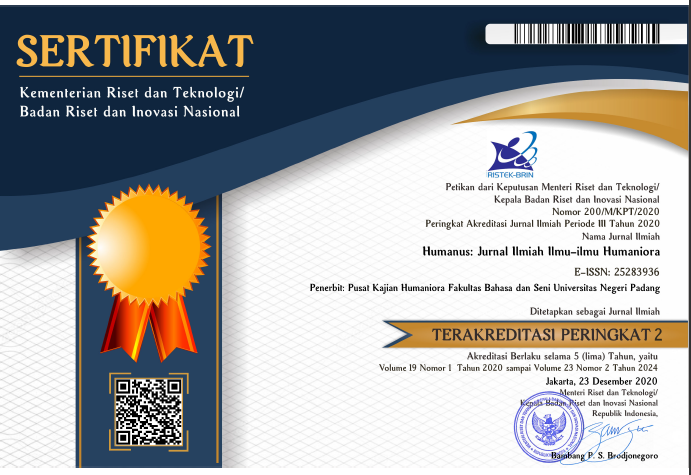Creating Local Icon through Traditional Opera: Suroloyo Dance Fragment in Kulon Progo and Canggeuk in Seoul
 ), Yuni Wachid Asrori(2), Niken Oktavia Shalsabilla(3),
), Yuni Wachid Asrori(2), Niken Oktavia Shalsabilla(3), (1) Gadjah Mada University
(2) Gadjah Mada University
(3) Gadjah Mada University
 Corresponding Author
Corresponding Author
Copyright (c) 2024 Ummul Hasanah, Yuni Wachid Asrori, Niken Oktavia Shalsabilla
DOI : https://doi.org/10.24036/humanus.v23i1.122403
Full Text:
 Language : en
Language : en
Abstract
Keywords
References
Afifuddin. 2009. Metodologi Penelitian Kualitatif. Bandung: CV Pustaka Setia
Dance, S., & Summer, N. (2000). Dance Ethnology and the Anthropology of Dance Author ( s ): Adrienne L . Kaeppler Published by : Congress on Research in Dance Stable URL : https://www.jstor.org/stable/1478285 REFERENCES Linked references are available on JSTOR for this article : referen. 32(1), 116–125.
Dho Selvy, Kyky Meryan. 2018. Koreografi Fragmen Tari Wanara Yaksa Karya Didik Bambang Wahyudi. Skripsi. Institut Seni Indonesia Surakarta. Surakarta.
Kaeppler, A. (2000). Dance Ethnology and the Anthropology of Dance. Dance Research Journal, 32(1), 116-125. doi:10.2307/1478285
Killick, Andrew. 2002. Korean "Ch'anggŭk" Opera: Its Origins and Its Origin Myth. Asian Music , Spring - Summer, 2002, Vol. 33, No. 2 (Spring - Summer, 2002), pp. 43-82. JSTOR: University of Texas Press.
Killick, A. P., & Killick, A. P. (2001). " Ch ’ anggŭk " Opera and the Category of the " Traditionesque " Ch ’ anggük Opera and the Category of the " Traditionesque ". 25(1), 51–71.
Picard, M., & Picard, M. (1990). " Cultural Tourism " in Bali : Cultural Performances as Tourist Attraction CULTURAL PERFORMANCES AS TOURIST ATTRACTION ’. 49(49), 37–74.
Prayudi, M. Agus. 2020. Prospek Pengembangan Pariwisata Berbasis Kearifan Lokal di Kabupaten Kulonprogo. Khasanah Ilmu : Jurnal Pariwisata Dan Budaya Volume 11 Nomor 1. Program Studi Perhotelan, Akademi Pariwisata STIPARY. Yogyakarta.
Roger M. Keesing, Cultural Anthropology: A Contemporary Perspective, translated by R.G. Soekadijo, Cultural Anthropology: A Contemporary Perspective. Second Edition. (Jakarta: Erlangga Publisher, 1992), 106
Suparyanti, Sutri. 2013. Analisis Potensi Kawasan Obyek Wisata di Kecamatan Ngargoyoso Kabupaten Karanganyar. Surakarta: Universitas Surakarta Muhammadiyah.
Tohirin. 2013. Bimbingan dan Konseling di Sekolah dan Madrasah (Berbasis Integrasi). Jakarta: Rajawali Pers
Wise, S., Buck, R., Martin, R., & Yu, L. (2020). Community dance as a democratic dialogue. Policy Futures in Education, 18(3), 375–390. https://doi.org/10.1177/1478210319866290
Yudiaryani, - (2010) Menuju Pembentukan “Ikon” Kesenian Daerah Istimewa Yogyakarta (Strategi Penguatan Kreativitas Pertunjukan Ketoprak). In: Seminar Publik dengan Tema: 'Teater, Modernitas, dan Identitas.” Dalam program kerjasama Australia-Belanda- Indonesia yang diselenggarakan oleh Universitas Sanata Dharma, 1 Juli 2010, Yogyakarta.
https://travel.tempo.co/read/1444964/siap-siap-disambut-tari-sri-kayun-saat-wisata- ke kulonprogo/full&view=ok
https://www.youtube.com/watch?v=W4GLxB1qHD0
 Article Metrics
Article Metrics
 Abstract Views : 191 times
Abstract Views : 191 times
 PDF Downloaded : 70 times
PDF Downloaded : 70 times
Refbacks
- There are currently no refbacks.
Copyright (c) 2024 Ummul Hasanah, Yuni Wachid Asrori, Niken Oktavia Shalsabilla

This work is licensed under a Creative Commons Attribution-NonCommercial 4.0 International License.










